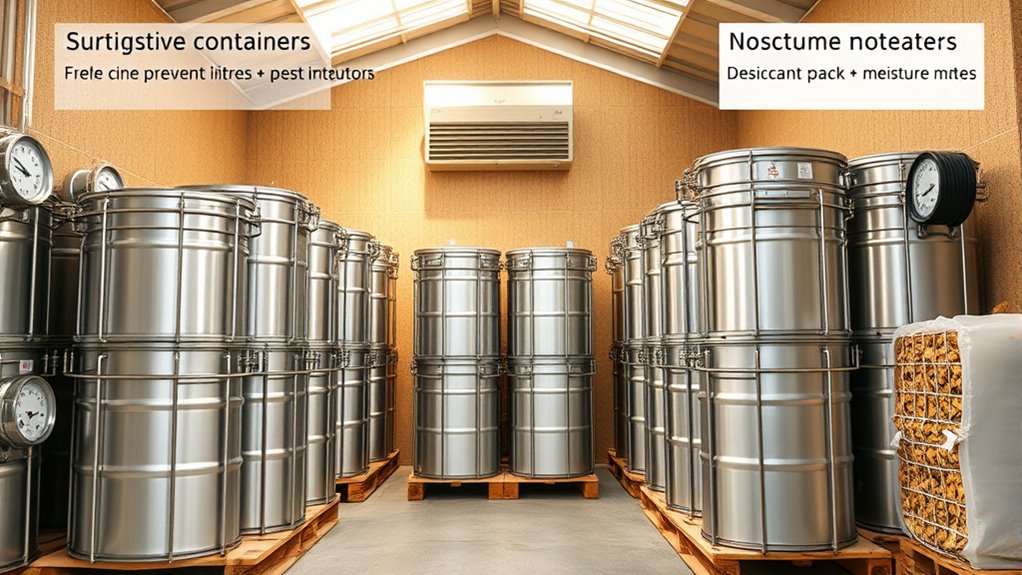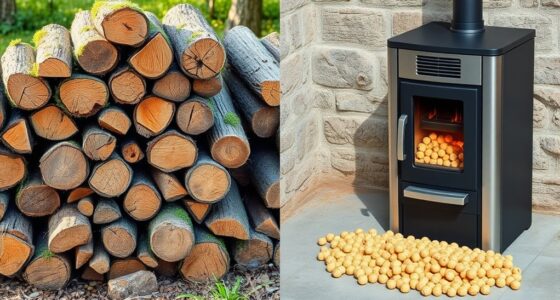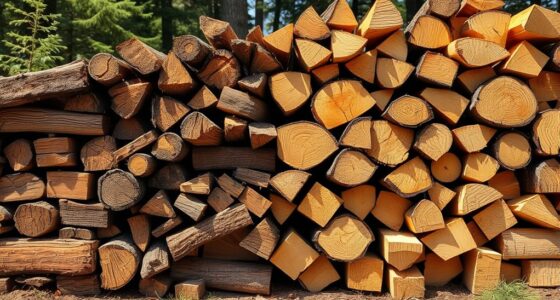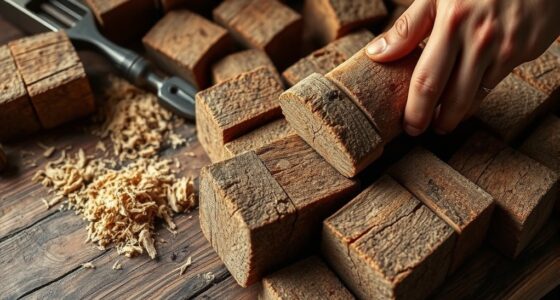To effectively store pellets and prevent moisture and pests, keep your storage area dry, well-ventilated, and tightly sealed. Use airtight containers, elevated platforms, and moisture barriers to maintain low humidity levels. Regularly inspect for pests, keep the area clean, and consider natural repellents for added protection. Avoid temperature fluctuations by storing in a cool, stable environment away from sunlight. If you continue, you’ll discover more tips to keep your pellets in top condition.
Key Takeaways
- Use airtight, sealed containers to prevent moisture ingress and pest entry.
- Store pellets in well-ventilated, dry areas with controlled humidity levels.
- Elevate storage containers off the ground to avoid ground moisture absorption.
- Regularly inspect and clean storage spaces to detect pests and prevent infestations.
- Maintain stable, cool temperatures away from heat sources and direct sunlight to reduce moisture and pest activity.

Proper storage of pellets guarantees they stay dry, maintain their quality, and burn efficiently. When you store pellets correctly, you prevent moisture from seeping in, which is essential because excess humidity can cause them to degrade, mold, or turn into unusable dust. Moisture prevention is key to ensuring your pellets remain in top condition, so always keep them in a dry environment. This means choosing a storage space that’s protected from rain, snow, and high humidity. Using a well-ventilated shed, a sealed container, or a specially designed pellet bin can help keep moisture out. Elevate your storage containers off the ground to avoid ground moisture seeping in and consider using moisture barriers or desiccants inside the storage area. Proper sealing and regular inspection help maintain a dry environment, ensuring your pellets stay fresh and effective for burning. Additionally, selecting appropriate storage containers that are designed to prevent air and moisture ingress is crucial for long-term pellet preservation. Implementing quality control measures can further ensure that your stored pellets remain optimal for use over time. Beyond moisture, pest deterrence plays a significant role in protecting your pellet stock. If you leave pellets exposed or store them in open containers, you risk attracting pests like insects, rodents, or other critters. These pests can not only consume your pellets but also introduce contaminants, mold, and bacteria, which compromise the quality and safety of your fuel. To prevent this, choose airtight containers that seal tightly, preventing pests from getting in. Regularly inspect your storage area for signs of pests or damage, and keep the area clean and free of food debris or other attractants. Consider using pest deterrents around the storage site or natural repellents inside the storage containers to further protect your pellets. Keeping the storage area tidy and secure is your best defense against pests. In addition to moisture prevention and pest deterrence, you should also consider the stability of the storage environment. Fluctuations in temperature can cause condensation or expansion and contraction of the storage container, which may compromise its seal. Maintaining a consistent, cool, and dry environment helps preserve pellet integrity over time. Always store pellets away from direct sunlight or sources of heat, as heat can accelerate degradation and promote pest activity. Incorporating climate control techniques can help maintain optimal conditions and extend the lifespan of your stored pellets. Additionally, choosing proper ventilation can help reduce humidity levels and prevent mold growth within the storage area.
Frequently Asked Questions
Can Pellets Be Stored Outdoors Safely?
You can store pellets outdoors if you guarantee proper outdoor protection and consider weather conditions. Use a waterproof, sealed container to keep moisture out, and place it in a covered, dry area away from direct sunlight and rain. Regularly check for signs of humidity or pests, especially during rainy seasons or extreme weather. Proper outdoor storage helps maintain pellet quality and prevents damage from weather considerations.
How Long Do Pellets Typically Last in Storage?
You’re playing with fire if you think pellets last forever. Generally, pellet shelf life depends on storage conditions, but they can last from 6 months up to a year if kept dry and pest-free. Proper storage duration prevents spoilage and maintains quality. Keep pellets in airtight containers, away from humidity, to extend their usability. By doing so, you’ll get the most out of your pellets without surprises down the line.
Are There Eco-Friendly Pest Control Options for Pellets?
Yes, you can choose eco-friendly pest control options for your pellets. Biodegradable options like diatomaceous earth work naturally to deter pests without chemicals. Natural repellents such as cedar chips or essential oils like peppermint and neem oil also help keep pests away. These methods are safe for the environment, effective, and won’t harm your pellets or surrounding ecosystem, making them ideal for eco-conscious storage.
What Signs Indicate Pellet Spoilage?
You’ll notice pellet spoilage if they absorb moisture, becoming soft or clumpy, which indicates moisture absorption. Mold growth is another clear sign, appearing as fuzzy or discolored patches on the pellets. If the pellets smell musty or off, that’s a sign they’ve gone bad. Always check for these signs before use, as spoiled pellets can be less efficient and may cause issues in your heating system.
Does Storing Pellets in a Basement Affect Their Quality?
Storing pellets in a basement can turn your storage into a disaster zone if you’re not careful. Basement moisture and humidity levels can skyrocket, causing pellets to swell, mold, or disintegrate into useless mush. Plus, pests love damp environments, so poor pest prevention can lead to infestations that ruin your supply. Keep your pellets dry, well-ventilated, and sealed to prevent moisture damage and pest problems.
Conclusion
To keep your pellets fresh and pest-free, always monitor humidity levels and store them in a cool, dry place—think of it as your modern-day alchemy for pellet preservation. Don’t forget to seal the container tightly, just like a treasure chest from a pirate’s tale. Remember, maintaining proper storage isn’t just about avoiding a catastrophe like the Great Fire of London; it’s about ensuring your pellets stay effective and ready whenever you need them.











